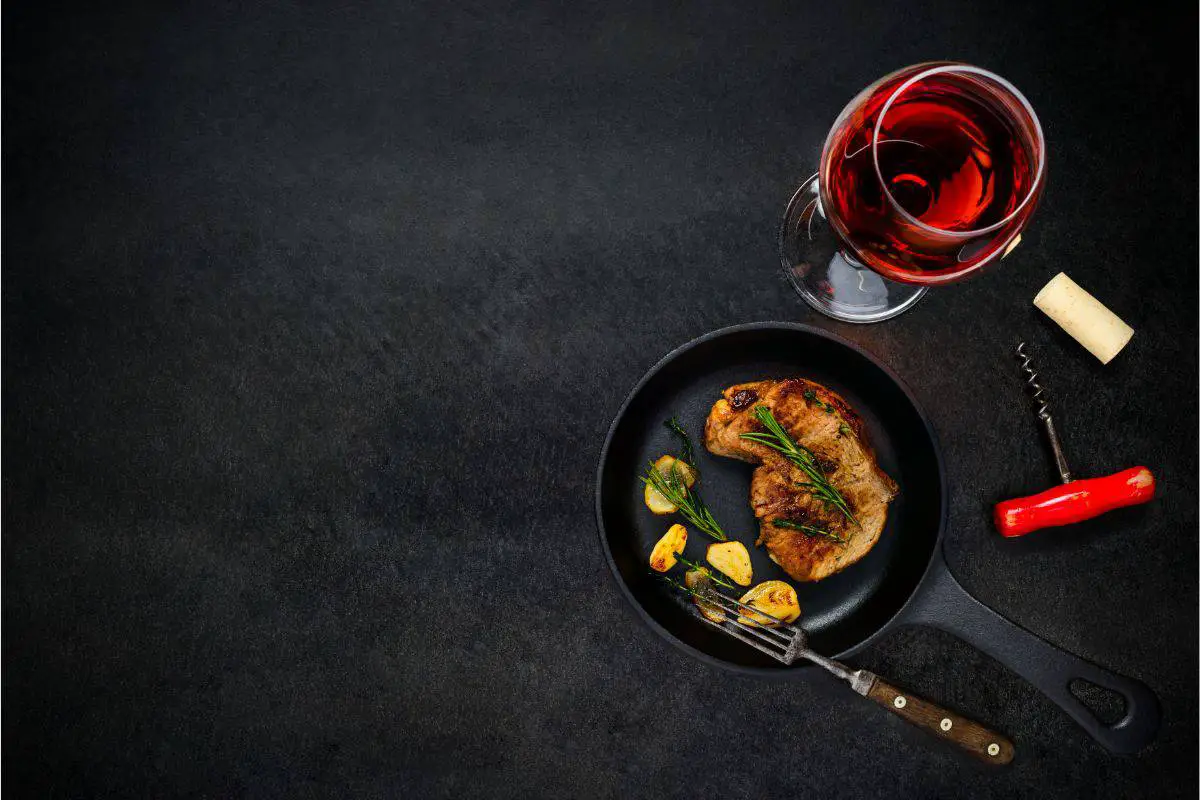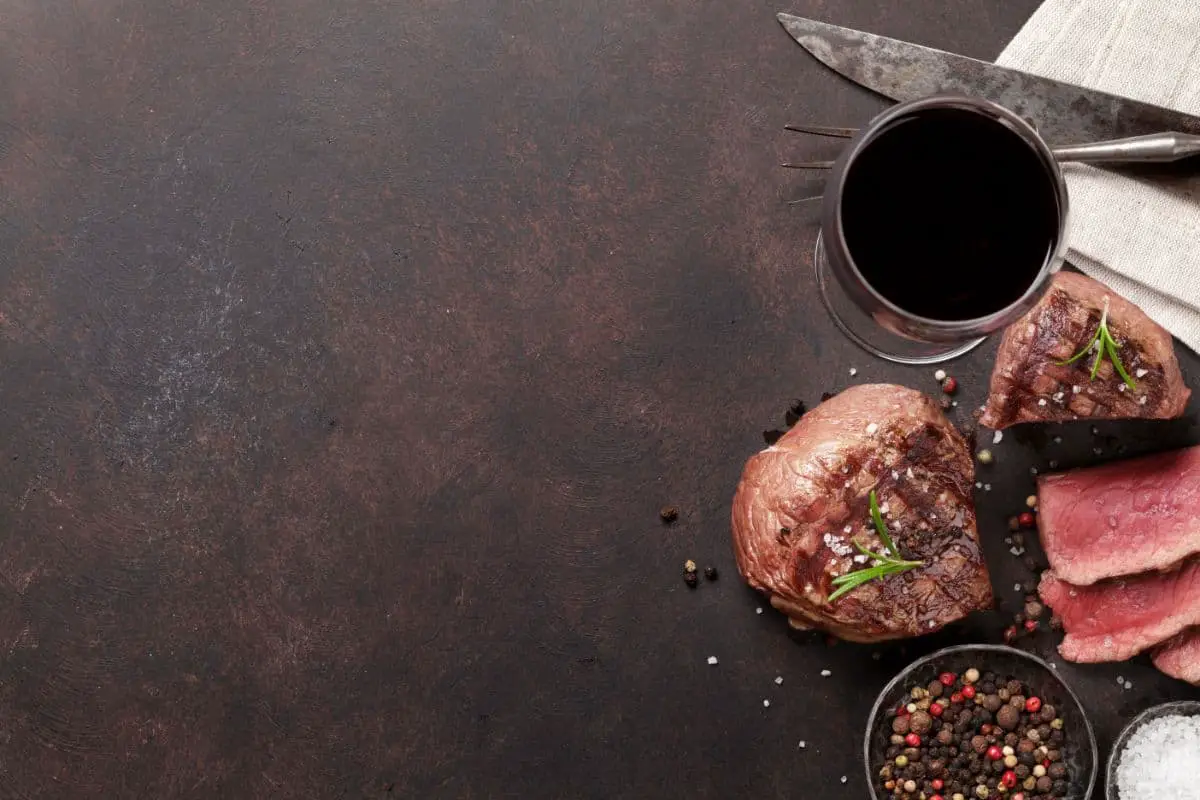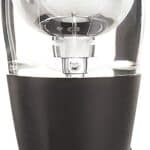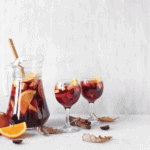Choosing the right wine to match your food can help elevate both your meal and your wine.
It’s seen as a sign of sophistication to be able to pick the best wine for every occasion and this is especially the case when it comes to steak.

Choosing the right wine for your steak is complicated as there are so many different cuts of steak and so many different seasonings that can be used.
Whether you’ve picked steak to celebrate a special occasion or are just eating a regular meal at home, picking the right wine will lift your meal and impress your guests.
That’s why we’ve created this article to help you choose the best wine to pair with your steak.
Let’s get started!
How To Choose The Best Wine With Steak – Things To Consider
Before we get into specific recommendations about which wine to pair with your steak, there are a few caveats that need to be taken into consideration.
You should keep these in mind when you choose the best wine for your steak.
Fattiness
Although there are certain cuts of steak that are predisposed to being more marbled or fattier than others, there can still be variation in the cuts themselves. The quality of the meat can also be a factor in this.
As a general rule, the fattier the steak is, the less robust the wine should be.
If you choose a rich and robust wine to match your fatty steak you might find that the combined richness of the alcohol and the meat can be overwhelming to your palate and you won’t enjoy either as much as you should.
If your steak is fatty, look for wines that have a higher acidity. This helps to balance out the fattiness of the steak and the umami flavors that are inherent in fatty steaks.
Seasoning
The seasoning of the steak can also have a great influence on which wine is the best for each steak.
Simple seasoning such as salt and pepper is a blank slate and virtually any wine will pair with these types of seasoning. They’re the most versatile and easiest to enjoy.
For steaks seasoned with sweeter ingredients, however, you should avoid any wines that are too sweet. You don’t want to match sweetness with sweetness as this will be too much.
By the same token, you shouldn’t match heavily spiced steaks with heavily spiced wines, either. Instead, opt for a wine that is light and fruitier to balance out the heavily seasoned meat.
Personal Preference
Although you can keep the fattiness and cut of the meat and the seasonings in mind when you choose your wine, ultimately, it is down to personal preference.
You can choose the perfect wine to match your steak but if it’s a wine that you or your guests don’t like, it won’t be a good choice.
Take our recommendations as starting points but don’t be afraid to deviate from them if a combination doesn’t work for you. As long as you’re enjoying both your wine and your steak, that is all that matters!
Wine And Steak Pairing Guide
Now that we’ve identified a few considerations that you should keep in mind when you choose your wine, let’s take a closer look at specific wines for specific cuts of meat.
We’re going to consider the most common cuts of steak and identify a few wines that go with each.

Sirloin
This is one of the most common and popular cuts of steak. It comes from the top of the cow’s back from the primal loin or subprimal sirloin.
It’s typically a lean steak that only has a little marbling and isn’t very fatty. It can often have a strip of fat along one edge but this typically doesn’t run through the steak.
Sirloin is one of those steaks that can be cooked and seasoned in a variety of ways so it’s one of the most flexible when it comes to wine choices.
You will need to keep in mind how the steak is being sauced and seasoned to pick the most suitable wine. This is why our choices for sirloin show some variety.
Wine Choices
- Spanish Tempranillo – these are typically medium to full-bodied wines that are quite fruity. They’re a good choice with most sirloins.
- Montepulciano – this is another medium-bodied wine and is best for sirloins that have a more savory and meaty seasoning.
- Shiraz – these wines are very fruity and can have a peppery finish to them. This makes them ideal for sirloins served with a buttery sauce.
Ribeye
Another very popular form of steak is ribeye. This is taken from the primal section of the beef rib and is just behind the chunk and the front of the loin.
Ribeyes can be either boneless or bone-in. Ribeyes are generally well-marbled and are very tender, making them one of the tastiest and most tender cuts available.
The bone-in version of ribeye can be more difficult to cook because of the rib bones still being attached but it’s no less delicious.
As ribeye has a relatively high-fat content, you need to choose wines that will complement this. Wines that are more bitter and complex are a great choice, as are those with strong flavors of fruit.
Wine Choices
- Cabernet Sauvignon – the bitterness of this wine makes it great for ribeye. We especially recommend it for ribeyes that are seasoned with rosemary.
- Zinfandel – this is a strong wine that pairs well with any ribeye that has been prepared on the grill.
- Valpolicella – this wine has a high acidity that comes from tart cherries. The strong fruit flavor mixed with a smoky taste makes it perfect for ribeye.
T-Bone / Porterhouse
These are two different cuts but they share enough features to make their wine pairings the same.
Both cuts are taken from the front section of a cow’s short loin but a porterhouse steak is taken from the rear and T-bones from the front.
Porterhouse steaks are much larger than T-bones but they have similar textures. They both have a firm strip side that is full of flavor with a more tender filet.
As the filet is tender and pretty lean, the best wines for these two steaks are aromatic wines. Look for red wines that are full of flavor.
Wine Choices
- Nebbiolo – these wines have strong flavors and are full of fruity flavors. They’re very aromatic too, with hints of cherry, rose, and anise.
- Xinomavro – full of flavor and with high acidity, these wines have strong hints of raspberry, plums, and allspice.
- Aglianico – these wines are full-bodied and full of red fruits such as cherries and plums.
Rump
As the name suggests, the rump steak comes from the rear of a cow. It’s between the sirloin and topside and is one of the firmest cuts of meat.
Due to this firmness, rump steak is often marinated before being served and this can make it a difficult steak to find a wine for. You will need to match both the cut and the seasonings.
Wine Choices
- Carménère – this is ideal for rump steaks that have been seasoned with marinades featuring parsley, cilantro, and garlic.
- Monastrell – this is a very robust wine that can cope with even the meatiest of steaks. Consider this for rump steaks marinated in meaty sauces.
- Dolcetto – this is a medium-body wine that has hints of dark berries. It’s a good all-around wine that suits most rump marinades.
Filet Mignon
This is one of the more expensive and delicious steaks. It’s taken from the tenderloin found in the middle of the back. It’s very lean and has little to no marbling or fat. This makes it a very tender cut of steak that is full of flavor.
It’s commonly served with a variety of sauces but can also be kept simple with just some salt and pepper or butter.
The flavor of filet mignon is subtle, so you need a wine that won’t overpower it. Instead, the wines should complement the delicate flavors.
Wine Choices
- Mencía – although this wine has some strong aromatics, its tart taste ensures it won’t overpower your steak.
- Merlot – this is a great all-arounder wine that works with a wide variety of different steaks. It has hints of cherry and chocolate and is medium-bodied.
- Touriga Nacional – this is ideal for rump steaks flavored with pepper. It’s a full-body wine with subtle hints of violet, blueberries, and plums.
Final Thoughts
In this article, we looked at the best wines to pair with steak. We considered the general points that need to be kept in mind when choosing the best wine and then looked at some specific wines for some of the most popular cuts of steak.
Ultimately though, it’s best to choose a wine that you like and to do some experimentation. Keep our tips in mind and you’re sure to find the best choices.
We hope that this guide will help you choose the best wine for your next steak.
- How to Learn Wine Tasting: Essentials for Beginners - March 10, 2024
- How to Learn to Like Wine: Cultivating an Appreciation for the Vintner’s Art - March 10, 2024
- Thanksgiving Sangria: A Flavorful Twist to Your Holiday Table - August 27, 2023








